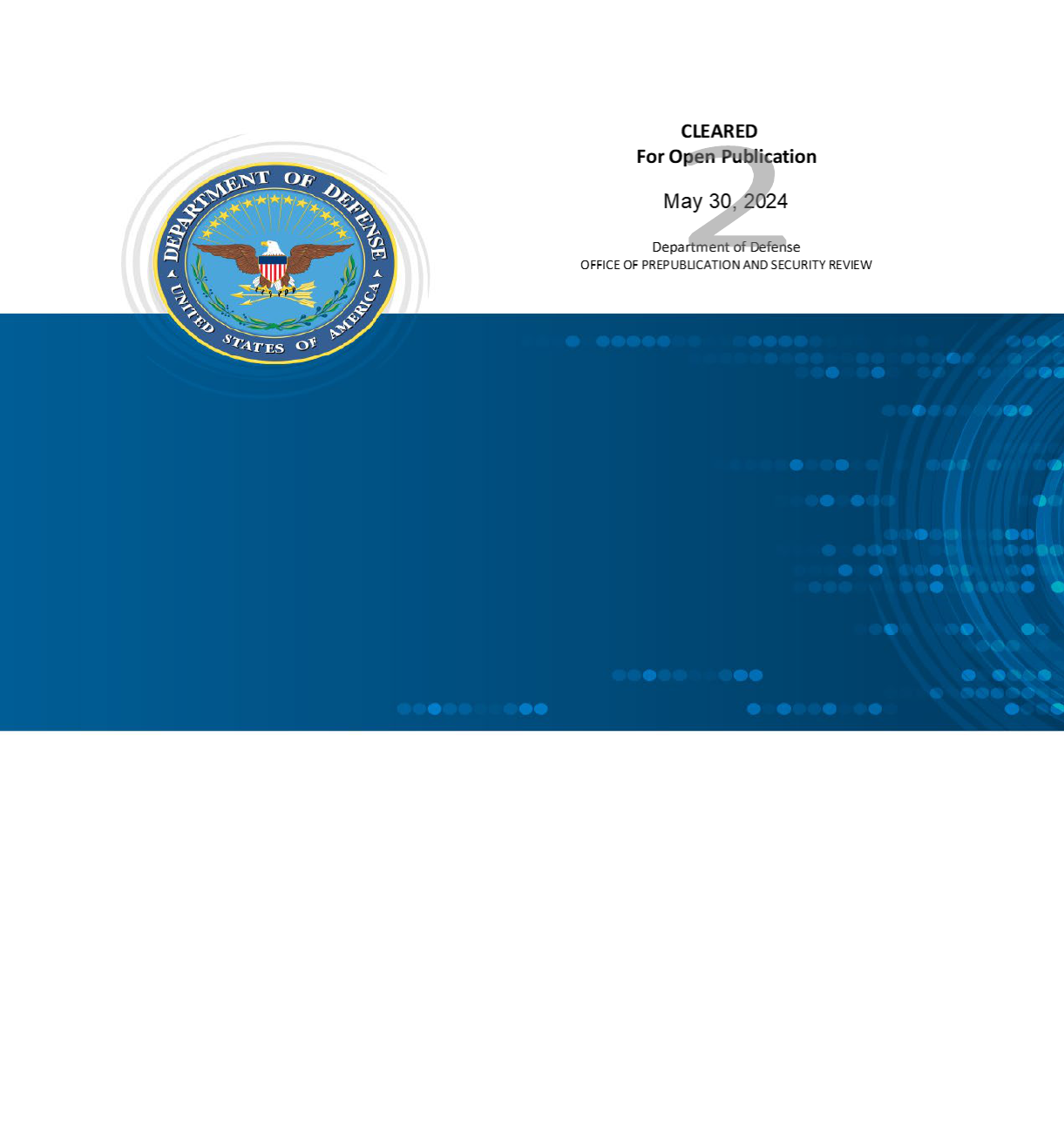
UNCLASSIFIED
Continuous Authorization to Operate (cATO) – Evaluation Criteria Page 1
UNCLASSIFIED
Continuous Authorization to Operate (cATO)
Evaluation Criteria
DevSecOps Use Case
29
May 2024
DISTRIBUTION STATEMENT A. Approved for public release: distribution unlimited
UNCLASSIFIED
Continuous Authorization to Operate (cATO) – Evaluation Criteria Page 2
UNCLASSIFIED
Contents
Executive Summary ........................................................................................................................ 3
Appendix A: DevSecOps Continuous Authorization to Operate: Scope for General Use Cases ... 5
Appendix B: DevSecOps Continuous Authorization: Implementation Guidance and Evaluation
Criteria ............................................................................................................................................ 7
Appendix C: DevSecOps cATO Assessment Overview ................................................................ 9
Appendix D: cATO Evaluation Criteria ....................................................................................... 10
1.0 Continuous Monitoring .................................................................................................. 10
2.0 Active Cyber Defense (ACD) ........................................................................................ 13
3.0 Secure Software Supply Chain (SSSC) and DevSecOps ............................................... 14
3.1 Authorize the DevSecOps Platform ................................................................................ 14
3.2 Authorize the Process ...................................................................................................... 15
3.3 Authorize the People ....................................................................................................... 16
Figure 1. Single Authorization Boundary ....................................................................................... 5
Figure 2. Multiple Authorization Boundaries ................................................................................. 6
Figure 3. Software Factory/Production Boundary .......................................................................... 6
Figure 4. Assessment Method Overview ........................................................................................ 7
Figure 5. cATO Memo Competency Assessment Crosswalk ......................................................... 9

UNCLASSIFIED
Continuous Authorization to Operate (cATO) – Evaluation Criteria Page 3
UNCLASSIFIED
DevSecOps Continuous Authorization to Operate
Evaluation Criteria
Executive Summary
To maintain a competitive advantage, the Department of Defense (DoD) must develop and
deploy software with increasing speed and agility, while improving security. Additionally, the
DoD must respond quickly to rapidly changing threats through the continuous integration and
delivery of capabilities, cybersecurity, resiliency, and survivability. The Department
accomplishes this using DevSecOps practices for software development. Software factories
(SWF) that use DevSecOps practices can mitigate threats early during software development as
well as during operations. To allow software delivery organizations to deploy more secure
software faster, the Department will implement a new approach to system authorizations:
Continuous Authorization to Operate (cATO).
Continuous Authorization to Operate (cATO) is a modernized authorization process designed to
work with software delivery organizations that want to move faster and are willing to adopt the
necessary culture change. cATO moves away from solely a document-based, point-in-time
technical security assessment approach (though some point-in-time documents are still required),
towards focusing on a continuous risk determination and authorization concept by continuously
assessing, monitoring, and managing risk. cATO raises the security standard over a traditional
Authorization to Operate (ATO) and provides the ability to deploy software more rapidly to the
field while improving security. (See Glossary for a more precise definition of cATO.)
A software factory with a cATO is allowed to continuously develop, assess, and deploy software
that meets the risk tolerances laid out within a system authorization boundary.
A DevSecOps cATO is based on continual assessment of the processes, the skills of its SWF
teams, and the use of a DevSecOps Platform that meets one of the DoD Enterprise DevSecOps
Reference Designs, and which implements continuous monitoring, active cyber defense, and the
National Institute of Standards and Technology (NIST) secure supply chain guidance.
Overview
This cATO Evaluation Criteria establishes the use cases and guidelines for evaluating a request
for continuous authorization for a software factory (for an explanation of a DevSecOps platform
and software factory, see DoD Enterprise DevSecOps Fundamentals).
Additionally, it provides the recommended processes and information required for software
factories to generate a cATO package and send to DCIO(CS) for review and approval. Appendix
A outlines the two use cases for which requesting a DevSecOps (DSO) cATO is appropriate.
Appendix B highlights the baseline guidance and assessment overview as well as the specific
information required for the cATO package. Please note that due to evolving requirements, this
UNCLASSIFIED
Continuous Authorization to Operate (cATO) – Evaluation Criteria Page 4
UNCLASSIFIED
is a living document on the RMF Knowledge Service. Appropriate communities will be notified
as updates are made.
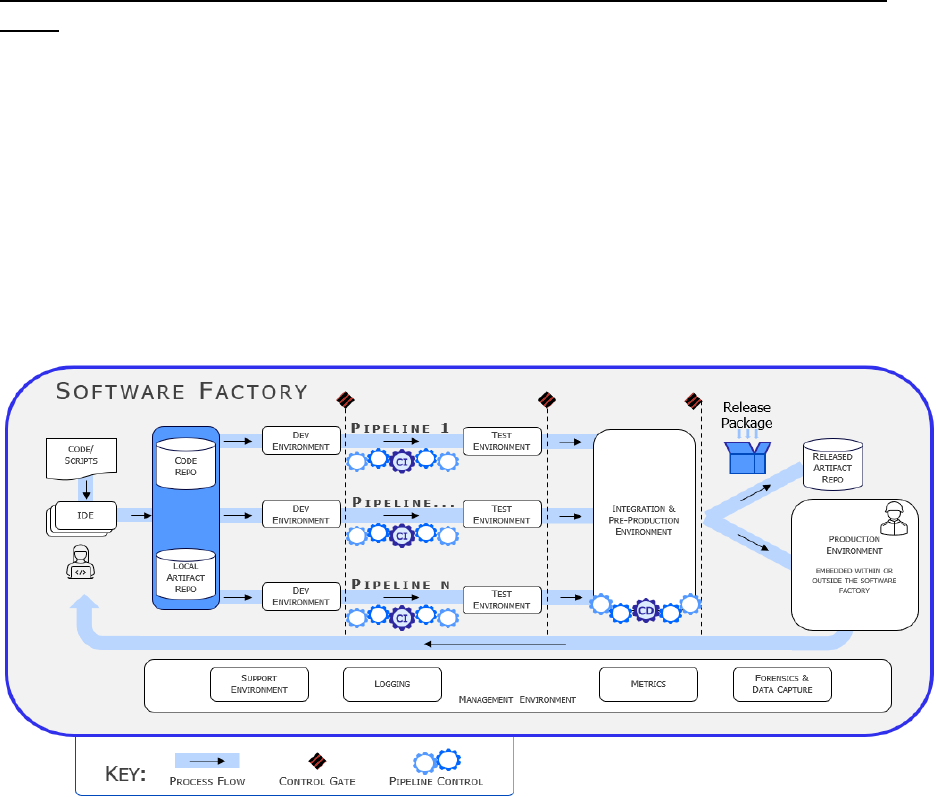
UNCLASSIFIED
Continuous Authorization to Operate (cATO) – Evaluation Criteria Page 5
UNCLASSIFIED
Appendix A: DevSecOps Continuous Authorization to Operate: Scope for General Use
Cases
Programs or software factories applying for a DSO cATO should already be in one of the
following use case categories.
Use Case 1 (Inside the Software Factory Boundary): A software factory uses a development,
security, and operations (DevSecOps) platform that already has an ATO. Software is developed
in that factory and deployed within its production environment (i.e., within its system boundary)
as depicted in Figure 1. The software factory seeks a cATO that includes its production
environment. This is the main use case for a SWF leveraging cATO. Example: Software
developed and put into production using the Platform One (P1) Party Bus. (Note: Information
flow includes development, test, and security artifacts).
Figure 1. Single Authorization Boundary
Use Case 2 (Outside the SWF Boundary): A software factory using a DevSecOps platform that
already has an ATO, but the software is deployed into another authorization boundary (e.g., a
weapon system) with its own ATO as depicted in Figure 2. The software factory seeks a cATO
for the factory that allows deployment into the production environment. This involves at least
two authorization boundaries and there must be agreements in place to pass software across the
boundary and subsequently pass results and feedback back to the software factory. Example: The
Forge Software Factory has an ATO to build software that is then deployed on Navy ships, each
of which have their own ATOs.
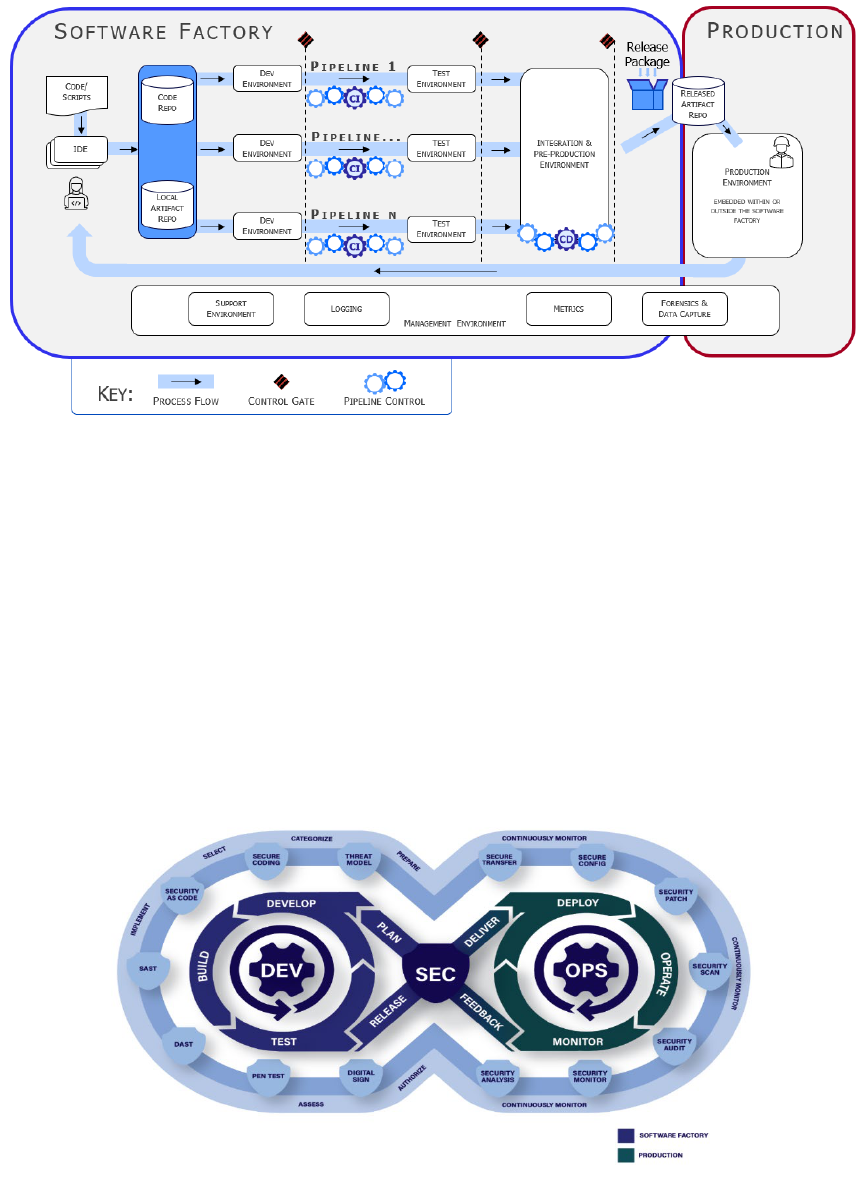
UNCLASSIFIED
Continuous Authorization to Operate (cATO) – Evaluation Criteria Page 6
UNCLASSIFIED
Figure 2. Multiple Authorization Boundaries
An outcome of issuing a cATO for use case 2 is to seamlessly deliver software factory products
into the production environment through a Memorandum of Understanding (MOU) and an
Interconnection Security Agreement (ISA).
Figure 3 shows the DevSecOps continuous lifecycle and the delineation between the software
factory that is primarily responsible for creating the software product and the associated
production environment where the software will execute. (Note: the outer path shows steps in the
Risk Management Framework (RMF) process, but this diagram does not directly map these to
the lifecycle phases. All the RMF steps must be followed, and the system must be in the
Monitor phase of RMF, before a system can apply for a cATO.)
Figure 3. Software Factory/Production Boundary
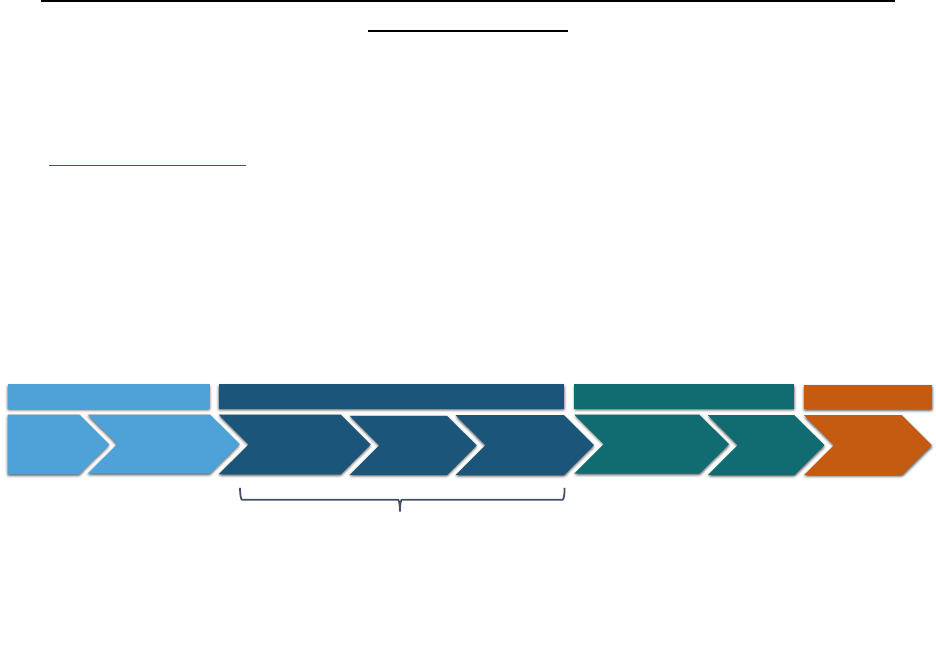
UNCLASSIFIED
Continuous Authorization to Operate (cATO) – Evaluation Criteria Page 7
UNCLASSIFIED
Appendix B: DevSecOps Continuous Authorization: Implementation Guidance and
Evaluation Criteria
While the DoD RMF Knowledge Service is the authoritative source for cATO implementation
guidance, this appendix provides an overview of how to assess a SWF for cATO along with the
requirements to deploy applications outside of the SWF authorization boundary in accordance
with DoD ISCM Strategy.
Figure 4 depicts an overview of the cATO assessment method. The top row shows the related
RMF steps: prepare, assess, authorize, and monitor. Other RMF steps (i.e., categorize, select, and
implement) take place outside the review process. The next row, with chevrons, indicates the
steps taken during the cATO assessment: identify assessors, develop an assessment plan, assess
the DevSecOps Platform (DSOP), assess the SWF teams, assess the DSO processes, develop a
cATO authorization recommendation, authorize the cATO, and constantly monitor the risk.
Figure 4. Assessment Method Overview
Software Factory practices required for cATO are informed by the existing RMF authorization to
operate assessment and the implementation of continuous monitoring. This assumes that before
applying for a cATO, the software factory has already progressed into the monitoring phase of
RMF and has a valid ATO. The cATO assessment further evaluates the ‘Prepare’, ‘Assess’, and
‘Authorize’ RMF phases. However, the key to receiving a cATO is having a robust continuous
monitoring strategy that includes automated triggers based on approved thresholds within the
auditing and incident response plans. The automated triggers and approved thresholds should
include both internal and external threats. Additionally, a complete understanding and
implementation (or planned implementation) of the shift security left and shield right concept
that incorporates vulnerability scanning and compliance checking with detection and response
activities to security incidents in real time. This includes tight integration with a Cybersecurity
Service Provider (CSSP) and Security Operations Center (SOC) if established. Hosting an
environment (development, test, staging, production, etc.) on a cloud requires the deployment of
a Cloud Native Application Protection Platform (CNAPP). Once the Chief Information Security
• Idenfy skills
• Train on method
• Idenfy acvies
• Develop schedule
• Idenfy costs
• Idenfy crical cATO
pracces
• Develop eval criteria
& scoring
• Coordinate with PMO
• Coordinate with AO
• Review key pracces
• Review evidence of use
• Interview personnel
• Score against eval criteria
• Capture findings
• Aggregate findings
• Roll up scores
• Develop
recommendaon
• Idenfy constraints
• Review with PMO
• Review with AO
• Review with
CISO
• CISO Issues
authorizaon
Identify
Assessors
Develop
Assessment
Plan
Assess
DevSecOps
Platform
Assess
Teams
Assess
Processes
Develop cATO
Authorizaon
Recommendaon
Authorize
cATO
Monitor
Risk
• Connuous
Monitoring
• Alert/Acon
triggered if issue
found
• Alert may
trigger a cATO
review
• If review
triggered, CISO
decides if cATO
revoked
Prepare Assess
Authorize
Monitor

UNCLASSIFIED
Continuous Authorization to Operate (cATO) – Evaluation Criteria Page 8
UNCLASSIFIED
Officer (CISO)
1
grants a cATO, continuous monitoring practices (including the CSSP) monitor
the risk. Upon identification of an issue or anomaly, the CSSP, along with the Security Control
Assessor (SCA), shall investigate and mitigate as necessary. If the issue or anomaly is outside of
agreed upon thresholds, the CSSP or SCA in collaboration with the Authorizing Official (AO)
may initiate a review of the cATO. If so, the CISO may decide to revoke the cATO. However,
with the approval of the originating Component authorizing official, the system can revert to its
original ATO by kicking off a new workflow in the Component’s RMF Inventory Tool, if the
cATO is revoked.
The approval to implement cATO process within a DevSecOps software factory is granted by
following the RMF guidelines identified in CNSSI 1253, NIST SP 800-53 and DoDI 8510.01. In
order to receive an approved cATO, the software factory must have a current ATO with no
‘High’ or ‘Very High’ unmitigated findings. The cATO analysis will review the existing
authorization, further evaluate the continuous monitoring strategy, ensure active cyber defense is
implemented properly, assess the DevSecOps and supply chain processes, and validate that they
are following cybersecurity supply chain risk management guidance in accordance with NIST SP
800-161r1.
1
Currently, this level of authority is at the DoD-level. Once cATO criteria is standardized for the DevSecOps use
case, the DoD CISO will delegate approval authority to the Component CISO or equivalent.

UNCLASSIFIED
Continuous Authorization to Operate (cATO) – Evaluation Criteria Page 9
UNCLASSIFIED
Appendix C: DevSecOps cATO Assessment Overview
The three competencies in the memo “Continuous Authorization to Operate (cATO),” February
3, 2022, are (1) Continuous Monitoring (CONMON), (2) Active Cyber Defense (ACD) and (3)
Secure Software Supply Chain (SSSC). However, the assessment of this use case is organized
into evaluating the DevSecOps Platform, Processes, and People (Teams). This section discusses
how to reconcile these two sets of concepts. To be considered for cATO, the environment must
ensure:
1) The DevSecOps Platform (DSOP) contains essential automation to enable CONMON,
ACD, and to support DevSecOps (DSO) tooling for a Secure Software Supply Chain
(SSSC).
2) Processes are defined for people using, operating, and maintaining the DSOP.
3) People are trained on the DSOP and its processes.
The cATO applies to the software factory, which includes the DSOP, and the software produced
by the software factory. The processes for using the SWF and DSOP must be clear, and the
people must be familiar with all aspects of DevSecOps.
Figure 5 depicts a high-level crosswalk between these two sets of concepts, showing how they
relate. The main columns represent the three competencies, while the rows show the three
aspects of the cATO Assessment.
Figure 5. cATO Memo Competency Assessment Crosswalk
cATO Memo Competencies
SSSC
&
DevSecOps
Active Cyber Defense
CONMON
Automation to secure the
supply chain, enforce
policy, and enable control
gates
Automation generates
evidence and alerts;
automatically kills bad
containers; CSSP integrated
with DSOP team
Generates, analyzes, and
displays machine
evidence throughout the
lifecycle in near real
-time
DSOP
cATO Assessment
DSOP engineering to
monitor and improve
practices
Ongoing active cyber testing,
including incident response
CONMON process
regularly validated and
tested
Process
Cyber dashboard collects
relevant information for all
DSO stages; all staff
trained on DSO process
Team understands active
cyber artifacts and approach
to defend; CSSP integrated
into team
Team trained on
CONMON automation
and DSOP alerts
generated by the software
factory
People
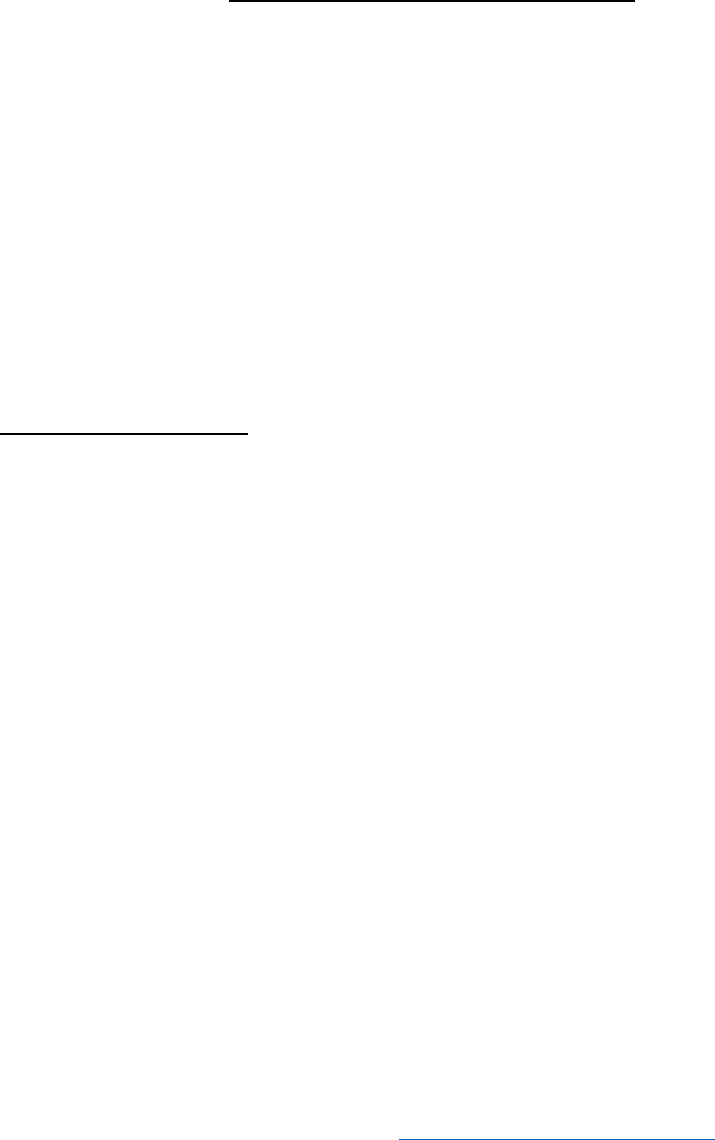
UNCLASSIFIED
Continuous Authorization to Operate (cATO) – Evaluation Criteria Page 10
UNCLASSIFIED
Appendix D: cATO Evaluation Criteria
The following list of activities associated with the Continuous Authorization to Operate (cATO)
competencies are what the DoD CISO considers when Component CISOs present systems that
are requesting to move into a cATO state.
The presence of these activities will be partly determined through demonstrated use of system-
level dashboards, which are a culmination of information received from logging, testing, and the
following activities to provide a real-time view of the environment. Components are not limited
to the way they conduct the following activities; however, this document offers guidelines to
achieving a cATO.
Items in bold in this section indicate documents or artifacts that must be delivered as part of the
application for cATO package.
1.0 Continuous Monitoring
• cATO Risk Management Strategy
o Must include established cATO risk tolerances based on the Components’ risk
posture guidance
o Must include process, management, and tracking of insider and external threats
o IAW DoDI 8510.01
• System CONMON Strategy
o Will be assessed IAW organizational Risk Management Strategy
o Includes plan to continuously assess and track vulnerabilities on all the system
assets within the infrastructure
o Includes determination of organizationally or software factory-specified metrics
(measures) to establish patterns and discern threats such as:
Implementation measures to measure execution of security policy
Effectiveness/efficiency measures to measure results of security services
delivery
Impact measures to measure business or mission consequences of security
events
o Includes timelines for continuous monitoring of security controls (automated
every hour, minute, second; manual once a year, etc.)
o Includes tight coupling with auditing and incident response strategies
• System Authorization Boundary Diagram
o Include data flows (including Personal Identifiable Information (PII)
o Include detailed information for all external connections IAW Appendix E
Diagram Requirements of the DISA Connection Process Guide
• Business Rules
UNCLASSIFIED
Continuous Authorization to Operate (cATO) – Evaluation Criteria Page 11
UNCLASSIFIED
o The following are examples of the type of business rules to be established by the
system:
Closely involve DoDM 8140.03certified cybersecurity experts throughout
the life of the program
Define and assign cybersecurity roles and responsibilities
Identify and retain Subject Matter Experts (SMEs) to ensure the
cybersecurity risk posture of the system is maintained during operations
Establish a vulnerability coordination Point of Contact (POC)
Align staffing to address detected and identified vulnerabilities
AO and designated cybersecurity personnel must have real-time access to
the results of testing, scanning, monitoring, and performance metrics at the
platform or application level in a mutually agreeable format (i.e.,
dashboards, alerts, etc.)
Identify, assess, prioritize, and share risk information in real time
Identify risks in real time and initiate corrective action plans to mitigate
them
• Automated Monitoring Information
o Status of dashboarding activities, including a demonstration of the dashboard in
operation
o Must be readily available and as near real time as feasible
o Includes a dashboard with relevant current information and requirements that
helps security personnel perform their tasks
o Must provide compliance reporting statistics to the Continuous Monitoring &
Risk Scoring (CMRS) system of record via automated processes if possible. If
not possible, manual reporting is required until automated process is developed.
o Includes an alerting capability that contacts security personnel when appropriate
o Demonstrate which security controls are fed into a system-level dashboard view,
providing a real time and robust mechanism for AOs to view the environment
o Helps secure the software supply chain, the software development pipeline and its
environment must be monitored as well
• System Authorization Package Documentation (leveraged from the Component’s
RMF Inventory Tool)
o Security Assessment Plan (SAP)
o Security Assessment Report (SAR)
o Risk Assessment Report (RAR)
o System Security Plan (SSP)
o ATO memo (Signed)
o Plan of Action and Milestones (POA&Ms)
o Update documents in response to CONMON process
Security Assessment
• Ensure it covers the DSOP supporting full lifecycle, including the
delivery pipeline and addresses:

UNCLASSIFIED
Continuous Authorization to Operate (cATO) – Evaluation Criteria Page 12
UNCLASSIFIED
o Threat modeling and vulnerability analysis
o Independent verification of assessment plans and evidence
o Penetration testing
o Attack surface reviews
o Manual code reviews
o Verifying the scope of Testing and Evaluation (T&E)
o Static Application Security Testing (SAST)
o Dynamic Application Security Testing (DAST)
o Interactive Application Security Testing (IAST)
• Continuity of Operations Plan (COOP) / Disaster Recovery Plan (DRP)
o Evidence of COOP/DRP testing
Examples include:
• Read-throughs, walk-throughs, simulations etc.
• Backup activities
• Restoration plan
• Incident Response Plan
o Incident Response Management
Evidence of a program in place that includes:
• Policies
• Plans
• Procedures
• Defined roles
• Training
• Proof of communication efforts
Examples of evidence include:
• Read-throughs, walk-throughs, simulations etc.
• Tabletop exercise
Capabilities to detect and respond to attackers
• Behavior Monitoring evidence
• Intrusion Detection/Prevention Systems evidence
• Continuous Vulnerability Management Documentation
o Evidence of mitigation
Published expectations and timelines for corrective action plans and
remediation efforts
Published plan to ensure availability of staff and resources
Findings tracked using Deficiency Reports and system-level POA&Ms
o Vulnerability scanning procedures IAW DoDI 8530.01
o Leverage process and automation to enable identification of highest priority items
and vulnerabilities to remediate (verified through documentation and
demonstration)

UNCLASSIFIED
Continuous Authorization to Operate (cATO) – Evaluation Criteria Page 13
UNCLASSIFIED
o Monitor for new threat and vulnerability information IAW DoD and Component
level Information Security Continuous Monitoring (ISCM) strategies.
Critical and moderate vulnerabilities are documented upon discovery
and mitigated within a timeframe acceptable to the AO
• Audit log analysis
o Collect, analyze, alert, review, and retain audit logs IAW NIST SP 800-53
security controls
o Evaluation of events that could help detect, understand, or recover from an attack,
as described in Appendix A of OMB M-21-31
• cATO Approval Memo (located on the RMF Knowledge Service (KS))
o While cATO approval authority resides with the DoD CISO, this template will be
filled out by the cATO Assessment Methodology Working Group and submitted
with the Components’ cATO package
2.0 Active Cyber Defense (ACD)
• Certified Cybersecurity Service Provider (CSSP)
o IAW DoDI 8530.01,Meeting the Evaluator’s Scoring Metrics requirements
o External - CSSP Service Level Agreement (SLA) for both on premises and cloud
systems
o Internal – Documentation of methodology supporting ACD
o Inherited – Agreements/documentation where integration occurs
o Outline scope and parameters of CSSP support for on-prem and cloud systems
o Employ CSSP sensors and tools to detect vulnerabilities
o Provide evidence that CSSP received training on DevSecOps principles for
the Software Factories that are being monitored
• External Assessment Results and Remediation Evidence
o A penetration test must be completed on development and operational
environments by a qualified third party within 90 days and annually thereafter,
with one of the following options, per the AO:
Cyber Operations Rapid Assessment (CORA)
Red/Blue Team assessment
Pen Testing
Exception-to-Policy is required for any other type of assessment
o Some areas of focus include, but are not limited to, the following:
Testing the effectiveness and resiliency of enterprise assets through
identifying and exploiting weaknesses in the cybersecurity defense posture
(people, processes, and technology), and simulating the objectives and
actions of an attacker.
Testing the authorization boundary IAW DoDI 8531.01, in search of
weaknesses that would allow unauthorized access.
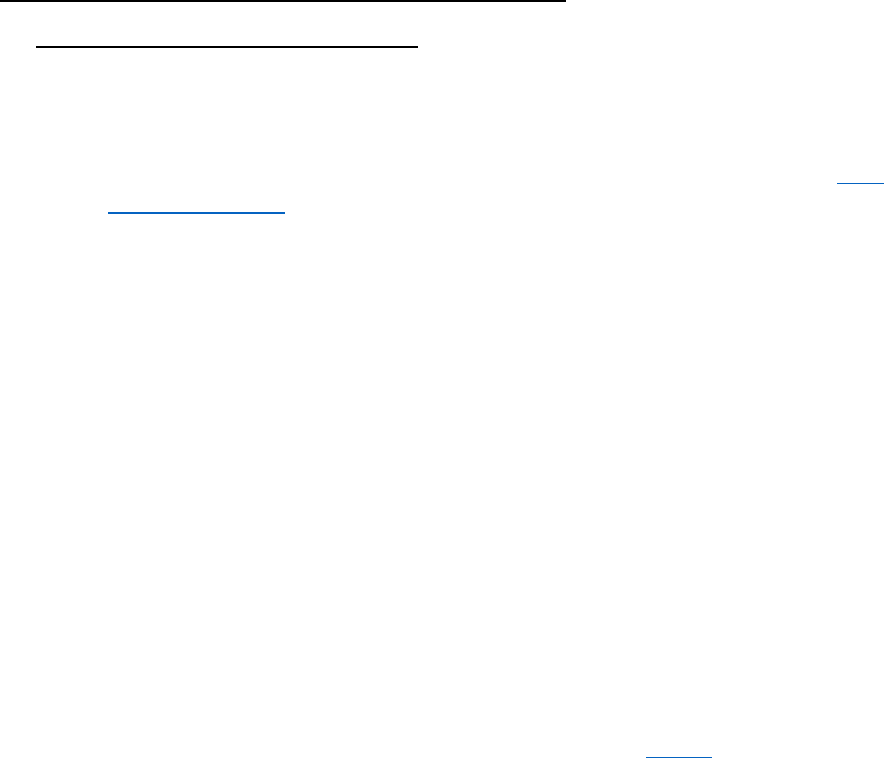
UNCLASSIFIED
Continuous Authorization to Operate (cATO) – Evaluation Criteria Page 14
UNCLASSIFIED
o Provide a Vulnerability and Penetration Assessment
o AO provided results with findings and planned mitigations.
o Updated document POA&Ms where appropriate
o Lessons Learned tracking
• Security Testing and Documentation
o Security testing should be conducted on an ongoing basis and test against
adversary tactics and techniques based on real-world observations
o Strategy and budget for automated cybersecurity testing resources
o Documentation of the ongoing iterations of cybersecurity analysis and penetration
testing
o Documentation and evaluation of the impact of system or environment changes to
the cybersecurity defense posture
3.0 Secure Software Supply Chain (SSSC) and DevSecOps
3.1 Authorize the DevSecOps Platform
• Use of a DevSecOps Platform (DSOP) that implements an approved DevSecOps
Reference Design, or implementation of an approved DevSecOps Reference Design
o Identify the DevSecOps Reference Design to which the DSOP adheres
o Approved DoD Enterprise DevSecOps Reference Designs are posted to the DoD
CIO public library
• Software Bill of Materials (SBOM)
o Provide a SBOM for the DSOP with a statement of how it was developed
o Provide an automated export of the SBOM for applications/products passing
through the DSOP
o Specify the SBOM format and how often it is generated
SBOM should be in one of the common formats:
• Software Package Data Exchange (SPDX)
• Software Identification Tags (SWID)
• CycloneDX
• However, the format has not yet been mandated. SBOM is
currently undergoing regulatory action, Defense Information
Systems Agency (DISA) Federal Acquisition Regulation (FAR) is
the lead
o Maintain an archive of SBOMs for products passing through pipelines. This can
be kept in the same area as the assessment evidence (e.g., results of security tests)
for the products
o Explain how the SBOMs are analyzed. If a new cybersecurity vulnerability
appears in the Common Vulnerabilities and Exposures (CVE®) system, explain
how the organization applies it to the SBOMs
• Activities and Tools Mapping

UNCLASSIFIED
Continuous Authorization to Operate (cATO) – Evaluation Criteria Page 15
UNCLASSIFIED
o Based on the DevSecOps Activities and Tools Guidebook, provide the mapping
of the required and preferred DevSecOps activities to the system’s
implementation.
o Include any additional documentation listed with the mapped activities in the
Activities and Tools Guidebook
o Provide Activities and Tools Mapping POA&Ms/Roadmap to show continuous
improvement
o Provide demonstration of various activities listed within the Activities and Tools
Guidebook (selected activities determined during the cATO evaluation)
• Cloud Native Application Protection Platform - Employ an integrated set of security
and compliance capabilities to secure and protect cloud-native applications across
development and production to include:
o Artifact Scanning:
Software Composition Analysis to review artifacts to find open-source
libraries included. This should be addressed in the creation of the SBOMs.
Application Security Testing such as SAST, DAST, and IAST
o Cloud Configuration:
Cloud Security Posture Management (CSPM) for continuous monitoring,
detection, and remediation of cloud security misconfigurations.
Cloud Infrastructure Entitlement Management (CIEM) for management of
access rights, permissions, or privileges for the identities of a single or
multi-cloud environment.
Infrastructure as Code (IaC) Scanning to find security flaws before
pushing to production.
o Runtime Protection:
Cloud Workload Protection (CWPP) to provide runtime enforcement
Cloud Detection and Response (CDR) to provide advanced threat
detection, incident response, and continuous monitoring capabilities
specifically designed for cloud environments.
3.2 Authorize the Process
• Reliance on Infrastructure as Code (IaC) and Configuration as Code (CaC) to avoid
environment drift
• Control Gate and Guardrail Analysis
o These processes should be described in the Incident Response Management
section above
o Provide a description of each control gate and what triggers cause the gate to
close and open. This should include what triggers an alert and how to respond to
that alert
o Demonstrate each control gate in action (this may be in a non-production
environment) or provide screen shots of control gate output as displayed in a
dashboard

UNCLASSIFIED
Continuous Authorization to Operate (cATO) – Evaluation Criteria Page 16
UNCLASSIFIED
o Provide a description of each guardrail and the process that occurs when
something is out of the risk tolerance for each guardrail
3.3 Authorize the People
• Verification of appropriate training for each member of the team(s), based on their
role(s)
o Provide an organization chart showing the roles within the DSO Team
o Demonstrate appropriate separation of duties and least privilege are applied to all
personnel
o Periodically conduct Tabletop Exercises with the whole team and produce After
Action Reports
Exercises should include:
• Security incident response procedures
• Standard procedures for the DSOP, including how to respond when
a control gate triggers
• How to respond to a security alert
• Requests for elevated privileges
• The organizational DevSecOps education, certification, and training process is
documented. Documentation need not be text documents but may be in online learning
management tools that assessors can view. Possible areas of training include Agile,
DevSecOps, secure coding, security automation tools, interpreting vulnerability scanning
reports, cATO method, etc.
o The team members are trained in the cATO method:
Trained on the appropriate version of the DoD Enterprise DevSecOps
Reference Design.
Trained on the security automation tools and how they are used.
Trained on the Continuous Integration/Continuous Delivery (CI/CD)
control gates, promotion rules, and the established risk tolerances.
Trained on the resolution / adjudication of security findings that result in
exceeding the risk tolerances.
Ability to perform root cause analysis of “critical” and “substantive”
security findings.
Trained in continuous monitoring feedback loops for ensuing continuous
risk monitoring against tolerances.
Trained in the establishment of POA&M and security dashboard
monitoring in a DevSecOps environment.
o Verification of appropriate training for each member based on their role on the
Product/Application Team, DSOP Team, or Security Team
o Verification of cybersecurity team member qualifications in accordance with DoD
DoDM 8140.03
UNCLASSIFIED
Continuous Authorization to Operate (cATO) – Evaluation Criteria Page 17
UNCLASSIFIED
o Document cross-functional team training and shadowing
• Insider Threat Monitoring
o Validate an insider threat working group is established, active, and chaired by
senior leadership
Validate insider threat working group identifies critical areas for review
along with thresholds for analysis
o The below concepts can be used to protect against insider threats:
Separation of duties
Paired programming
Least privilege management with respect to containers/cloud
environments
• Onboarding/Offboarding
o An onboarding/offboarding process is defined for new team members based on
their role.
o Show evidence that all personnel have gone through the
onboarding/offboarding process, without regard to their rank or position.

UNCLASSIFIED
Continuous Authorization to Operate (cATO) – Evaluation Criteria Page 18
UNCLASSIFIED
Glossary
Authorization boundary “All components of an information system to be authorized for
operation by an authorizing official. This excludes separately authorized systems to which the
information system is connected.” NIST 800-37r2.
Authorizing Official (AO) is “a senior Federal official or executive with the authority to
authorize (i.e., assume responsibility for) the operation of an information system or the use of a
designated set of common controls at an acceptable level of risk to agency operations (including
mission, functions, image, or reputation), agency assets, individuals, other organizations, and the
Nation.” NIST 800-37r2.
Authorization to Operate (ATO) is “the official management decision given by a senior
Federal official or officials to authorize operation of an information system and to explicitly
accept the risk to agency operations (including mission, functions, image, or reputation), agency
assets, individuals, other organizations, and the Nation based on the implementation of an
agreed-upon set of security and privacy controls. Authorization also applies to common controls
inherited by agency information systems.” NIST 800-37r2.
Continuous Authorization to Operate (cATO) is the state achieved when the organization that
develops, secures, and operates a system has demonstrated sufficient maturity in their ability to
maintain a resilient cybersecurity posture that traditional risk assessments and authorizations
become redundant. This organization must have implemented robust information security
continuous monitoring capabilities, active cyber defense, and secure software supply chain
requirements to enable continuous delivery of capabilities without adversely impacting the
system’s cyber posture.
Continuous Integration/Continuous Delivery (CI/CD) Pipeline is the process workflows and
associated tools to achieve the continuous integration and continuous delivery of software with
maximum use of automation.
Control gate is a defined point in the project lifecycle when specific requirements, called exit
criteria, must be met to move to the next phase in the lifecycle. Exit criteria include functional,
security, and non-functional criteria.
DevSecOps is a software engineering culture and practice that aims at unifying software
development (Dev), security (Sec) and operations (Ops). The main characteristic of DevSecOps
is to automate, monitor, and apply security at all phases of software development: plan, develop,
build, test, release, deliver, deploy, operate, and monitor.
DevSecOps Platform (DSOP) is the set of tools and automation that enables a software factory.
It includes the ability to create DevSecOps pipelines with control gates, and to deploy software
into development and test environments. It may also deploy into production, depending on the
production environment. Use of a DevSecOps platform is encouraged to accelerate development,
delivery, and authorization. DoD Enterprise DevSecOps Reference Designs for a DSOP may be
found here.
ISCM is defined as “maintaining ongoing awareness of information security, vulnerabilities, and
threats to support organizational risk management decisions.” NIST SP 800-137.
UNCLASSIFIED
Continuous Authorization to Operate (cATO) – Evaluation Criteria Page 19
UNCLASSIFIED
Software Factory is a software assembly plant that contains multiple pipelines, which are
equipped with a set of tools, process workflows, scripts, and environments, to produce a set of
software deployable artifacts with minimal human intervention. It automates the activities in the
develop, build, test, release, and deliver phases. The software factory supports multi-tenancy.
System is any organized assembly of resources and procedures united and regulated by
interaction or interdependence to accomplish a set of specific functions. NIST 800-37r2.
